| home > 2011 financial > consolidated > review of consolidated balance sheet, income statement and financial position |
home > 2011 financial > consolidated > review of consolidated balance sheet, income statement and financial position
review of consolidated balance sheet, income statement and financial position
Income Statement
The Rai Group income statement for 2011 shows a net profit of 4.1 million euros, against a loss of 98.2 million euros for
2010. The difference with the result of the Parent Company Rai S.p.A., which presents a net profit of 39.3 million euros, is
largely determined by the elimination of the dividends disbursed by the Group companies in relation to the previous year’s
results against those for the 2011 year-end.
In relation to the decision made by the Parent Company in 2011 to close down Rai Corporation, the condition by which
the company must be considered as a going concern ceased to exist. Consequently, Rai Corporation, besides booking the
charges envisaged for the liquidation of the company, is no longer consolidated using the line-by-line method from this year.
In order to ensure a consistent comparison between the results of this year and the previous one, an income statement and a
balance sheet resulting from the deconsolidation of Rai Corporation have been drawn up as the term of reference for 2010,
as highlighted by the reclassified statements at the side.
The following section provides an overview of the main items of the income statement and the reasons behind the more significant
changes from the previous year.
Revenues from sales and services
Revenues from sales and services consist of licence fees, advertising revenues and other commercial revenues.
They totalled 2,973.9 million euros, down 38.7 million euros (-1.3%) on 2010.

A breakdown of revenues from sales and services, per company and net of operations between Group companies, is presented
in the following table.
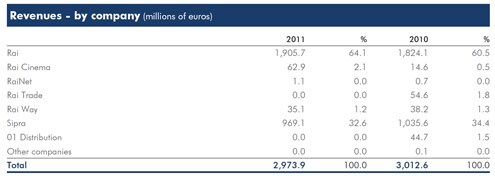
Licence fees (1,708.4 million euros). These include licence fees for the current year as well as those for previous years,
collected through coercive payment following legal registration. Uncollected fees from those exempted from payment of the
licence fee are also included, albeit for a residual amount.

The overall increase (+1.4%) refers to the increase in the per-unit licence fee from 109.00 euros to 110.50 euros (+1.4%).
There has also been an increase in the number of paying subscribers (+0.2%) and a drop in new subscribers (-3.1%), returning
to the level of 2009.
Advertising revenues. In a framework characterised by the deceleration of the economy and the drop in consumption, advertising
revenues also recorded evident signs of difficulty in 2011.
Overall, the revenue trend in 2011 should be interpreted not only in the light of the deceleration of the global economy, which
induced a generalised downsizing of the advertising budget, but also of the comparison with 2010, a year characterised by
the presence of big sports events, such as the South Africa World Cup and the Vancouver Winter Olympics.
The figures of Nielsen allow the estimate of a comprehensive market reduction of almost 4%, with significant reductions on
all media, apart from the Internet, which closes at 12.3%. Television and radio advertising investments in particular show a
decline of 3.1% and 7.8% respectively.
In this context, the Rai Group’s advertising revenues (964.8 million euros) highlight a reduction of 64.1 million euros
(-6.2%) compared with 2011, as shown in the table below.
Revenues from advertising on specialised channels continue to show significant growth (+21.4 million euros, +71.1%).

Other revenues show an increase of 2.4 million Euros (+0.8%), due to a number of opposing factors, as highlighted in the
table below.
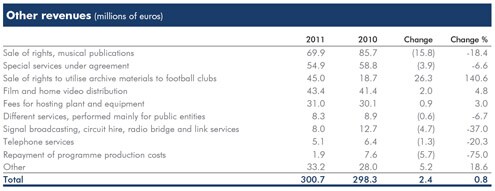
The main discrepancy factors include the Sale of rights to utilise archive materials to football clubs caption, which presents an
increase of 26.3 million euros as a consequence of the various agreements entered into by the Parent Company during the
two years, while Sale of rights and musical publications (-15.8 million euros) was negative, the reduction being largely due
to the sale of rights for foreign broadcasts of the matches of the Italian football championship in relation to different types of
agreements for these operations (-5.4 million euros), without significant net effects on the income statement, and to Musical
publications (-3.1 million euros).
Other, less important reduction factors are Special services under agreement (-3.9 million euros) as a consequence of the
reorganisation of activities envisaged under the foreign broadcasting agreement, Repayment of programme production costs
(-5.7 million euros), mainly due to the absence of income related to the production of a long-running TV fiction series, and
Signal broadcasting, circuit hire, radio bridge and link services (-4.7 million euros) determined mainly by the absence of income
following the termination of a satellite broadcasting agreement, with similar effects on costs.
A breakdown of other revenues, per company and net of operations between Group companies, is presented in the following
table.
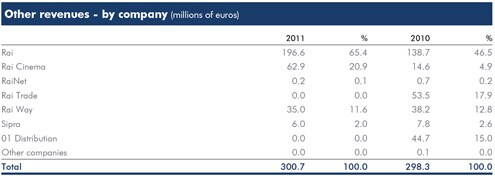
As indicated in the table below, the incidence of revenues from licence fees is about 57% of the total, while the advertising
and other revenues component is about 43%.

Operating costs
These total 2,278.6 million euros, falling 120.5 million euros compared with 2010, equating to 5.0%, the reasons for which
are listed below.
The item includes internal costs (labour cost) and external costs, regarding ordinary business activities, according to the following
classification.
Cost of goods and external services – This caption includes purchases of goods and services required to make programmes
of immediate-use (purchases of consumables, external services, artistic collaborations, etc.), filming rights for sports events,
copyright, running costs (rental and hire fees, telephone and postage, cleaning, maintenance, etc.) and other operating costs
(direct and indirect taxes, contribution to the Authority, the public broadcasting concession fee, etc.).
As highlighted in the table, in comparison with the previous year, the caption presents a reduction of 138.4 million euros
(-10.0%), largely deriving from the reduction in costs to purchase broadcasting rights, mainly for sports events (-85.9 million
euros). As in all even numbered years, 2010 was characterised by the presence of important four-yearly sports events (World
Cup Football Championships and Winter Olympic Games) which had influenced the 2010 income statement by 107.8 million
euros. This reduction is partly offset by higher costs for the purchase of the rights to the Italian National football team’s friendly
matches and the qualifiers for the 2012 European Championship.
In addition to that highlighted above, widespread savings have been observed in other components of the caption, confirming
the continuation of cost containment policies.
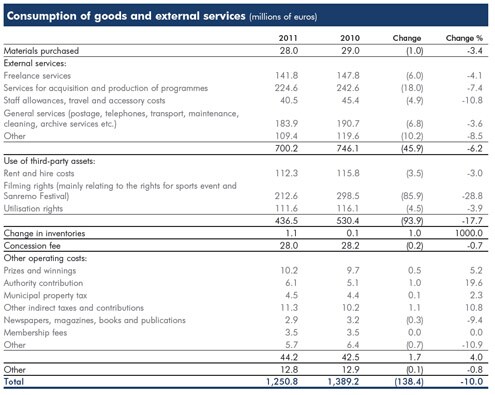
A breakdown by individual Group company of the cost of goods and services, net of transactions between Group companies,
is given in the following table:
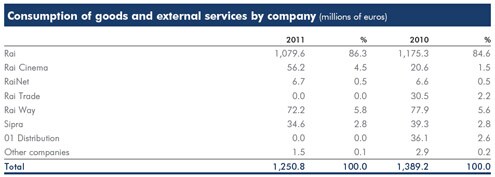
Personnel costs – These amount to 1,027.8 million euros, up by a total of 17.9 million euros on the total at 31 December
2010 (+1.8%), as detailed in the table below.

The growth of personnel costs is justified by the allocation of funds for the bonus systems applied to executives, middle management,
white and blue collars, not envisaged in the previous year as no bonuses were paid. In addition to this component,
personnel costs for 2011 close at a very similar value to 2010.
This result derives from a series of operational manoeuvres aimed at offsetting the economic growth deriving from contractual
automatisms, the stabilisation of staff on temporary contracts, the rise in the severance pay revaluation index and provisions
to cover contractual holiday periods for middle management, blue and white collars and orchestra staff.
Among the actions taken, the most significant weight can be attributed to incentives for resignation and the substantial blockage
of management policies.
A breakdown of personnel costs by individual Group company is given in the following table.
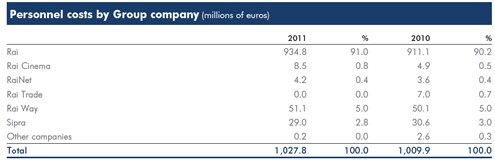
Personnel on payroll at 31 December 2011 (including 66 work-introduction and apprenticeship contracts) amounted to
11,410, up 55 on the same date of the previous year. In detail, Group company leavers numbered 331, of whom 156 left
under resignation incentives, while engagements numbered 386, 317 of which following the signing of permanent employment
contracts by temporary workers in application of trade union agreements, 20 returns to work following legal action and
3 compulsory placements.
The average number of employees, including those on fixed-term contracts, came to 13,133, down 115 from the previous
year due to a reduction of 30 in the number of staff on permanent contracts and reduction of 85 in the number of staff on
fixed-term contracts.
Gross Operating Margin
The Gross Operating Margin, as a consequence of the above, is positive for 719.7 million euros, up 78.4 million euros, or
12.2%, on the previous year.
Amortisation of programmes
This caption is related to investments in programmes which, during 2011, amounted to 491.9 million euros, down 17.9
million euros (-3.5%), mainly regarding TV fiction series, as highlighted in the following table.

A breakdown of investments in programmes by each individual company is shown in the following table:

Amortisation charged to the above captions for the year, 487.1 million euros, shows a reduction of 19.9 million euros
(-3.9%) compared with the previous year, related to the performance of investments.

Other amortisation and depreciation
The 2011 movement in this caption, shown in the following table, is linked to investments in non-current tangible assets
and other investments, and presents a total increase of 51.4 million euros (-34.3%), largely determined by the acquisition
of the DEAR property complex by the Parent Company for an amount of 52.5 million euros.
The tables below show the breakdown by company and type:


Amortisation and depreciation for the period referring to the captions mentioned above amount to 130.2 million euros,
with an increase of 9.0 million euros compared to 2010, referring mainly to non-current tangible assets.

Other net income (expense)
The caption comprises costs/revenues not directly related to the Company’s core business and, in 2011, highlights net expenses
of 39.6 million euros (32.1 million euros in the previous year). In detail, the caption comprises expenses relating to
repeat-usage programmes which it is not expected will be used, repeated or commercially exploited for 29.9 million euros
(at 31 December 2010, 42.8 million euros), provisions for risks and charges for 18.1 million euros (at 31 December 2010,
19.0 million euros), provision for bad debts for 6.3 million euros (at 31 December 2010, 8.4 million euros), provision to the
supplementary pension fund for former employees for 13.9 million euros (at 31 December 2010, 9.7 million euros), partly
offset by net prior-year income for 21.2 million euros (at 31 December 2010, 29.2 million euros) and releases of provisions
allocated in previous years for 8.8 million euros (at 31 December 2010, 20.0 million euros).
Operating result
The results described above for operating revenues and costs led to an improvement in the operating result, from -19.0 million
euros in the previous year to +62.8 million euros this year, with an increase of 81.8 million euros.
Net financial expense
Net financial expense shows a negative 9.5 million euros, down on 2010 (-0.4 million euros).
The caption shows the economic
effects of typical financial operations and comprises bank interest expense and income as well as that relating to Group
companies and net income/expense in relation to exchange rates.

The details show a drop in net interest payable to banks of 3.7 million euros against higher financial exposure to third parties
and an increase in the rates applied.
Net charges on exchanges, of 0.9 million euros, are down 3.9 million euros on the previous year.
This result is particularly
determined by exchange rate differences on Rai Cinema contracts in US Dollars, for which, compliant with company policy,
insurance coverage was provided in previous years. Other financial charges are down due to higher bank commissions and
interest payable to suppliers for payment extensions established by contract.
The average cost of loans, consisting of current account credit lines, “hot cash”, stand-by and medium-term loans, settled at
2.8% (1.9% in the previous year), up in relation to the increase in the spreads applied to bank loans.
Net exceptional expense
This caption amounts to 6.8 million euros (45.6 million euros in 2010), relating mainly to expenses sustained for the pursuit
of incentivised early staff resignation launched in the previous year.
Income taxes
These amount to 36.7 million euros and represent the balance between current and deferred taxes as shown in the table.
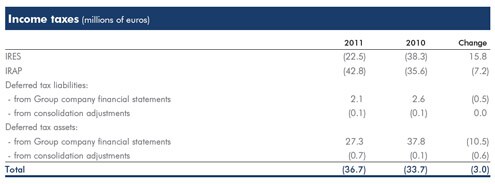
IRES of 22.5 million euros presents a reduction of 15.8 million euros on the previous year’s figure, relating to the better economic
results of certain Group companies.
No amount was recorded for IRES for the Parent Company, as the year is expected to have a negative tax result.
IRAP for 42.8 million euros is up on the previous year, due to the higher taxable amount of the Parent Company.
Deferred tax liabilities in 2011 determine a positive effect equating to 2.1 million euros (2.6 million euros in 2010), largely as
a consequence of the reversal of the temporary differences in income deriving from higher amortisation applied by the Parent
Company in previous years, purely for tax purposes.
Deferred tax assets (27.3 million euros) originated from the booking of IRES credit deriving from:
• the negative taxable base of the Parent Company, which was offset by the positive taxable amounts of the subsidiaries,
included within the scope of consolidation for the 2011 tax year for 16.5 million euros;
• temporary differences in income of the Parent Company which will be accrued to the next year and were determined largely
on the basis of the Group’s expected taxable income for that year, for an amount of 8.5 million euros;
• other changes for 2.3 million euros.
Balance Sheet aggregates
Non-current assets

Tangible assets are detailed in the following table.

Investments in programmes are represented mainly by TV fiction series (470.3 million euros) and films (313.5 million
euros).

Equity investments amount to 12.2 million euros and present a reduction on the previous year (-4.0 million euros), largely
due to the writedown of the investment in Rai Corporation following the decision to close this company down.
Other non-current assets are shown in the following table:

Working capital
The change from 2010 (+73 million euros) is due mainly to normal developments in the business.

Major changes relate to:
• Trade receivables: up 48.6 million euros due to increased lending positions mostly determined by fewer collections by
the Parent Company for Special services relating to agreements with the government.
• Other assets: up 78.6 million euros largely due to advance payments made by the Parent Company to purchase the
broadcasting rights for sports events held during the following year (particularly the European Football Championships and
Olympic Games).
• Trade payables: up 48.2 million euros due to certain amounts payable relating to contracts with football clubs and for
the purchase of sports broadcasting rights and the DEAR property.
Net financial position
The year-end net financial position is negative by 272.4 million euros, showing a considerable deterioration compared to
the previous year (-154.2 million euros) and is comprised as follows:

Despite the substantially balanced economic result, the growth of the debt is determined significantly by the change in certain
working capital entries, mainly due to delayed collections of receivables from services rendered to the government and relevant
disbursements for future big sports events (European Football Championships, Olympic Games).
In May 2011, an unsecured loan of 295 million euros was taken out, at the best market conditions, by a pool of five bank
counterparties, 210 million euros of which had been used at 31 December 2011. The loan, converted in observance of the
company policy to fixed rate for about 70% via an Interest Rate Swap, envisages full repayment by 31 December 2015, with
amortisation beginning in June 2013, in constant six-monthly instalments.
The loan envisages the respect of two parametric/equity indexes:
• Net Financial Debt, net of government receivables for licence fees/Shareholders’ equity ≤ 1.5
• Net Financial Debt, net of government receivables for licence fees/Gross Operating Margin ≤ 1
These indexes were fully respected at 31 December, settling at 0.49 and 0.36 respectively.
The average financial position is negative by about 254 million euros and has deteriorated compared to the previous year
(-188 million euros).
The analysis carried out on the basis of additional balance sheet and income statement ratios highlighted that:
• the net invested capital coverage ratio, calculated as the ratio between net invested capital and own capital, is 1.51
(1.29 at 31 December 2010);
• the financial debt coverage ratio, calculated as the ratio between net financial debt and own capital, is 0.51 (0.29 at
31 December 2010);
• the current ratio, identified in the ratio between current assets (inventories, current assets, cash and cash equivalents and
financial receivables) and current liabilities (current liabilities and financial debts), is 0.87 (0.73 at 31 December 2010);
• the self-coverage ratio of non-current assets, calculated as the ratio of shareholders’ equity to non-current assets, is 0.33
(unchanged from 31 December 2010).
The financial risks to which the Group is exposed are monitored using appropriate computerised and statistical instruments.
A policy regulates financial management in accordance with best international practice, the aim being to preserve the corporate
value by taking an adverse attitude towards risk, pursued via active monitoring of the exposure and the centralised
implementation of suitable hedging strategies by the Parent Company, also acting on behalf of the subsidiaries.
In particular:
• The exchange risk is significant in relation to the exposure in US dollars generated by the acquisition of rights to sports
events in foreign currencies by Rai (as well as the funding of the foreign associated company Rai Corporation) and of film
and television broadcasting rights by Rai Cinema. These commitments generated payments for about 220 million dollars
during 2011. Operation takes place from the date of subscription to the commercial commitment, often lasting several
years, and aims to defend the counter value in euros of commitments estimated at the time of order or in the budget.
Hedging strategies are implemented using financial derivative instruments – such as forward purchases, swaps, and options
structures – without ever taking on an attitude of financial speculation. The Group policy envisages numerous operating
limits to be observed by the hedging activity.
• The interest rate risk is also regulated by the company policy, particularly for medium/long-term exposure with specific
operating limits. In relation to the taking out of the medium-term loan described above, Interest Rate Swap agreements
were entered into for 205 million euros (of which 131 with start delayed until 31 December 2011), with the aim of transforming
the cost of the loan, issued at floating rate and therefore subject to market volatility, to fixed rate.
• The credit risk on cash deployment is limited in that the company policy envisages the use, for limited periods of cash
timing differences, of low-risk financial instruments with parties with high ratings. Only tied deposits or sight deposits with
remunerations close to the Euribor rate were used during 2011.
• As regards the liquidity risk, the Group, faced with a period of considerable uncertainty on the monetary market, consolidated
its financial structure by taking out the medium-term loan described above, of which, at 31 December 2011, 210
million euros had been used (thanks to the possibility for use extended to the whole of the first year following subscription).
With the banking system, short-term and reversible loan lines were opened for a maximum amount of about 515
million euros which, during recent tensions on the financial markets, presented problems relating to complete usability.
Stand-by loans are also active for a total of 130 million euros, maturing in February 2012 and renewed during the first
quarter of 2012 for the amount of 90 million euros. The loans in place allow coverage of overdrafts during the year, on
condition that payment of the fees by the Ministry of the Economy and Finance takes place without significant delays on
the contractual quarter-end deadlines. In the absence of relevant public funds, preparatory activities continued with the
European Investment Bank for a specific medium/long-term loan to provide further coverage of the relevant requirements
of the progress of the DTT project.
 |
 |